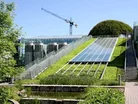New Research Challenges the Perception that Sustainability Costs

New research challenges the perception that sustainable buildings are necessarily more costly to construct, by presenting the actual costs and savings associated with a wide range of sustainable building strategies.
A research team from Sweett Group and BRE applied cost data from real construction projects to three case study buildings – an office, secondary school and community healthcare centre – to produce detailed capital and operational cost information.
Their report, Delivering sustainable buildings: Savings and payback, presents the actual costs of a range of individual sustainability strategies, and the additional costs (if any) of achieving various levels of overall building sustainability. In addition it reveals the associated payback to be gained from reduced utility costs.
The study investigated:
- The capital costs of measures to improve sustainability, including readily usable no or low cost measures, along with those that must be built into the project early on to minimise their costs;
- The capital costs of achieving overall levels of building sustainability, using the costs associated with gaining Pass, Good, Very Good and Excellent ratings under the BREEAM sustainability rating scheme;
- The life cycle costs of operating buildings, focusing on energy and water consumption – the study found that specifying sustainability measures during the design and procurement stages can bring cost savings without adding significantly, or at all, to upfront costs.
The researchers concluded that achieving the lower BREEAM ratings can incur little or no additional cost. Targeting the higher BREEAM ratings, and so more challenging levels of sustainability, incurs some additional cost but this is typically less than two percent. The investigation of lifecycle operational costs showed that any additional cost can be paid back within two to five years through utility savings.
Yetunde Abdul, Non-domestic Group Manager at BREEAM UK, and one of the report’s authors, said: “This study adds to a growing body of work on the costs and value of sustainability. It provides further strong evidence that a sustainable approach need not add significantly to building costs. And, where there are additional capital costs, these can be repaid relatively quickly through the reduced costs of operating the building.
“This report provides a practical resource to help developers and their project teams target and then deliver buildings that meet high standards of environmental performance” added Adam Mactavish, Operations Director – Management Consulting, for Sweett Group.
- AWS' Mission to Reduce the Environmental Impact of BuildingsTechnology & AI
- Top 10 most sustainable buildings in the worldBuilt Environment
- CLC aim to reduce diesel on UK sites by 78% before 2035Facilities Management
- Where to get support for BIM or green building certificationConstruction Projects



